Report on Business Environment, Organizational Structure and Northgate
VerifiedAdded on 2020/10/22
|20
|5164
|207
Report
AI Summary
This report provides a comprehensive analysis of the business environment, focusing on different types of organizations including public, private, and voluntary sectors, with a specific emphasis on Northgate Information Solutions. It explores the size and scope of these organizations, comparing examples like Atomic Weapons Establishment and The British Red Cross Society. The report delves into various organizational structures such as functional, divisional, and matrix structures, illustrating their applications. It also examines essential organizational functions like marketing and finance. Furthermore, it assesses the impact of macro-environmental factors on Northgate Information Solutions and evaluates its internal strengths and weaknesses, concluding with a summary of the key findings and references.
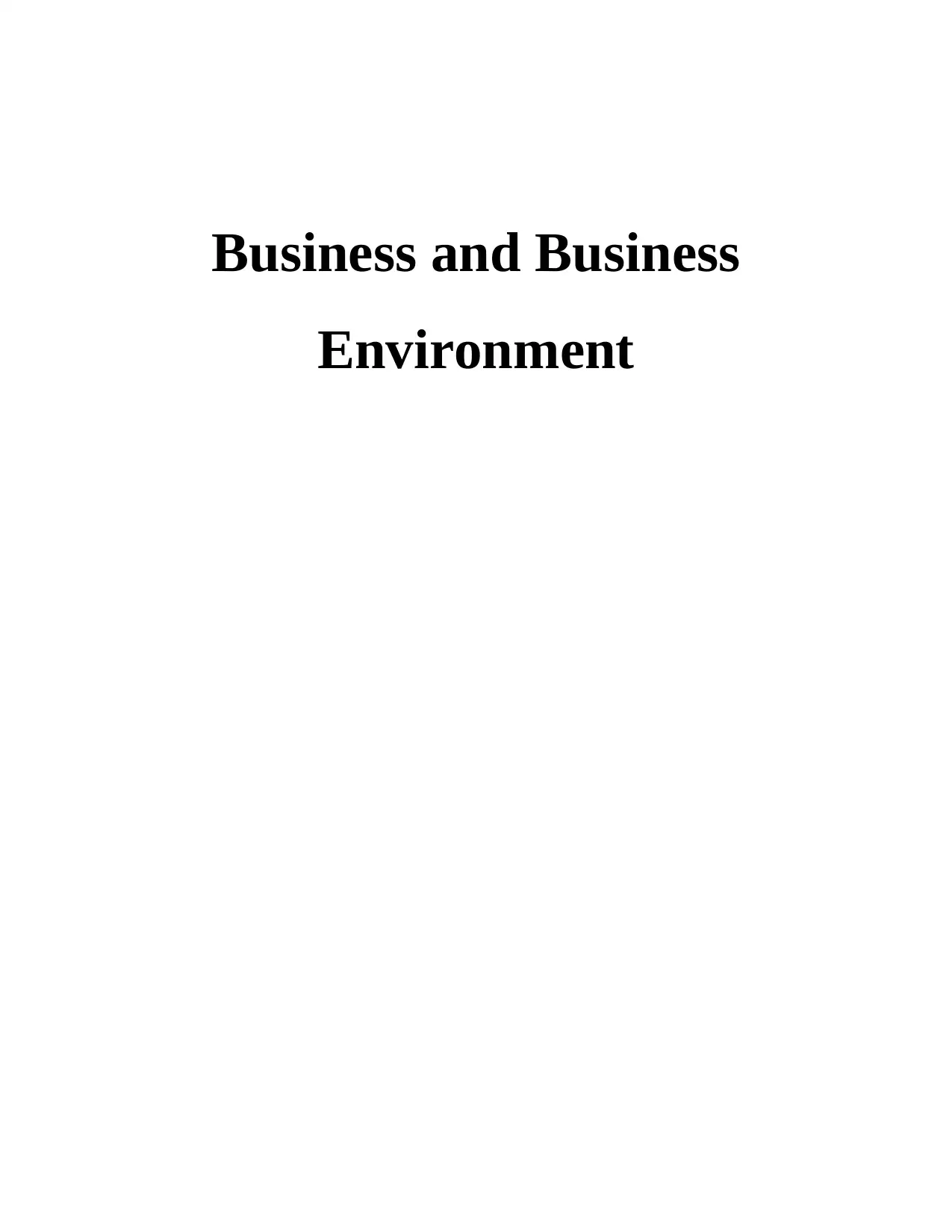
Business and Business
Environment
Environment
Paraphrase This Document
Need a fresh take? Get an instant paraphrase of this document with our AI Paraphraser
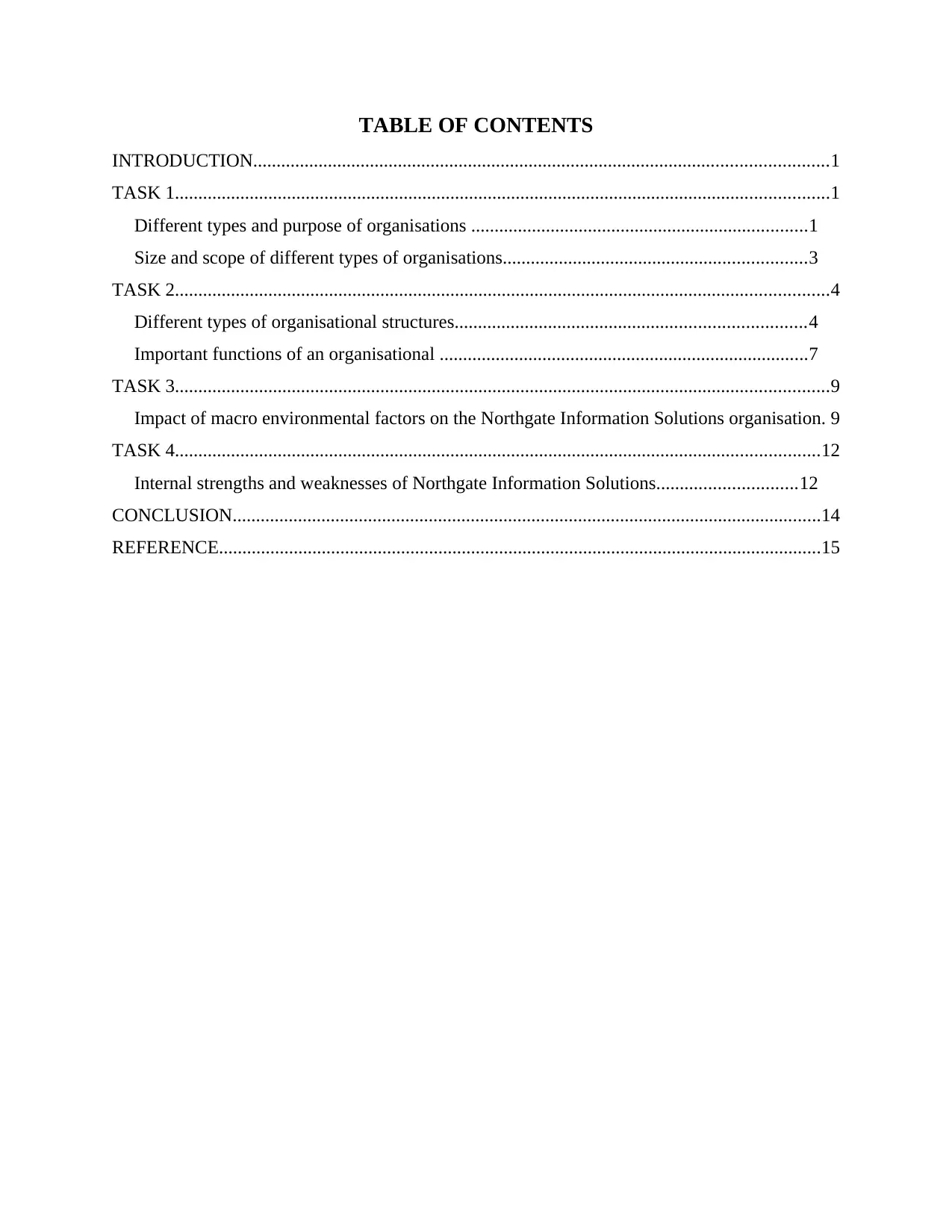
TABLE OF CONTENTS
INTRODUCTION...........................................................................................................................1
TASK 1............................................................................................................................................1
Different types and purpose of organisations ........................................................................1
Size and scope of different types of organisations.................................................................3
TASK 2............................................................................................................................................4
Different types of organisational structures...........................................................................4
Important functions of an organisational ...............................................................................7
TASK 3............................................................................................................................................9
Impact of macro environmental factors on the Northgate Information Solutions organisation. 9
TASK 4..........................................................................................................................................12
Internal strengths and weaknesses of Northgate Information Solutions..............................12
CONCLUSION..............................................................................................................................14
REFERENCE.................................................................................................................................15
INTRODUCTION...........................................................................................................................1
TASK 1............................................................................................................................................1
Different types and purpose of organisations ........................................................................1
Size and scope of different types of organisations.................................................................3
TASK 2............................................................................................................................................4
Different types of organisational structures...........................................................................4
Important functions of an organisational ...............................................................................7
TASK 3............................................................................................................................................9
Impact of macro environmental factors on the Northgate Information Solutions organisation. 9
TASK 4..........................................................................................................................................12
Internal strengths and weaknesses of Northgate Information Solutions..............................12
CONCLUSION..............................................................................................................................14
REFERENCE.................................................................................................................................15
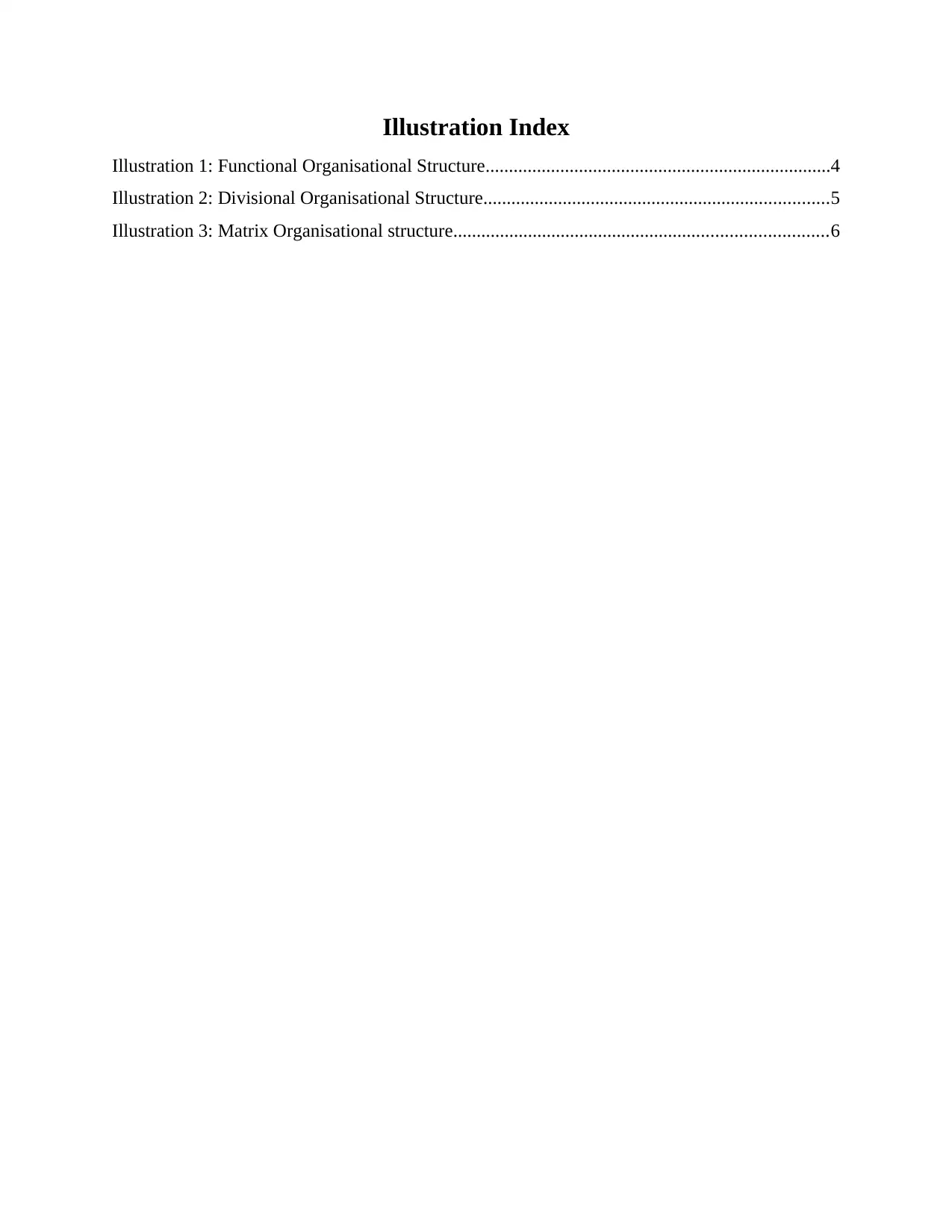
Illustration Index
Illustration 1: Functional Organisational Structure..........................................................................4
Illustration 2: Divisional Organisational Structure..........................................................................5
Illustration 3: Matrix Organisational structure................................................................................6
Illustration 1: Functional Organisational Structure..........................................................................4
Illustration 2: Divisional Organisational Structure..........................................................................5
Illustration 3: Matrix Organisational structure................................................................................6
⊘ This is a preview!⊘
Do you want full access?
Subscribe today to unlock all pages.

Trusted by 1+ million students worldwide

INTRODUCTION
The business environment includes different internal & external factors, forces that
cannot be controlled by any company. It may influence the organisational work and several
functions of management, performance of employees & staff members with growth of company
(Abrahamsen, Asche and Dahl, 2017). In other words, it refers as collection of all factors, that
may not be control by the management team of an organisation.
It is based on Northgate Information Solutions that is situated at United Kingdom and provides
various services of former computer manufacturer. It will also cover different types of
organisation with their size, scope and relationship between various organisational functions.
Further, it will include positive and negative impacts of macro environment on the business.
Lastly, it will cover internal strengths and weaknesses of Northgate Information Solutions
organisation.
TASK 1
Different types and purpose of organisations
Organisation comprises group of persons that work together to achieve different goals
and targets. They are organised & well-structured and their roles, responsibilities and duties
depends on their authority (Antonatos and et.al., 2017). It is known as open system and its
activities may impact on environment and it also influences by internal and external
environment. An organisation has several kinds for example private, public and voluntary. In this
context, these are describe as follows:
Public sector organisation – It is an essential type of organisation that runs and operated by the
government and offer its products and services to public. It is totally different from voluntary
sector organisations because it operates for certain objectives and for making profits. These are
depends on their legislation and govern by the local, state and by national legal bodies. It plays
an essential role for providing products and services to the citizens.
This sector encompasses critical and universal services, for example Electricity,
Emergency Services, Infrastructure, Fire Service, Gas & Oil, Healthcare, Law Enforcement
national defence, firefighting, homeland security, urban planning, corrections, taxation, police
protection and many more (Baraibar‐Diez and et.al., 2017). Main purpose of such organisations
is to provide better services to the public and do work for their welfare In this context, there is a
1
The business environment includes different internal & external factors, forces that
cannot be controlled by any company. It may influence the organisational work and several
functions of management, performance of employees & staff members with growth of company
(Abrahamsen, Asche and Dahl, 2017). In other words, it refers as collection of all factors, that
may not be control by the management team of an organisation.
It is based on Northgate Information Solutions that is situated at United Kingdom and provides
various services of former computer manufacturer. It will also cover different types of
organisation with their size, scope and relationship between various organisational functions.
Further, it will include positive and negative impacts of macro environment on the business.
Lastly, it will cover internal strengths and weaknesses of Northgate Information Solutions
organisation.
TASK 1
Different types and purpose of organisations
Organisation comprises group of persons that work together to achieve different goals
and targets. They are organised & well-structured and their roles, responsibilities and duties
depends on their authority (Antonatos and et.al., 2017). It is known as open system and its
activities may impact on environment and it also influences by internal and external
environment. An organisation has several kinds for example private, public and voluntary. In this
context, these are describe as follows:
Public sector organisation – It is an essential type of organisation that runs and operated by the
government and offer its products and services to public. It is totally different from voluntary
sector organisations because it operates for certain objectives and for making profits. These are
depends on their legislation and govern by the local, state and by national legal bodies. It plays
an essential role for providing products and services to the citizens.
This sector encompasses critical and universal services, for example Electricity,
Emergency Services, Infrastructure, Fire Service, Gas & Oil, Healthcare, Law Enforcement
national defence, firefighting, homeland security, urban planning, corrections, taxation, police
protection and many more (Baraibar‐Diez and et.al., 2017). Main purpose of such organisations
is to provide better services to the public and do work for their welfare In this context, there is a
1
Paraphrase This Document
Need a fresh take? Get an instant paraphrase of this document with our AI Paraphraser
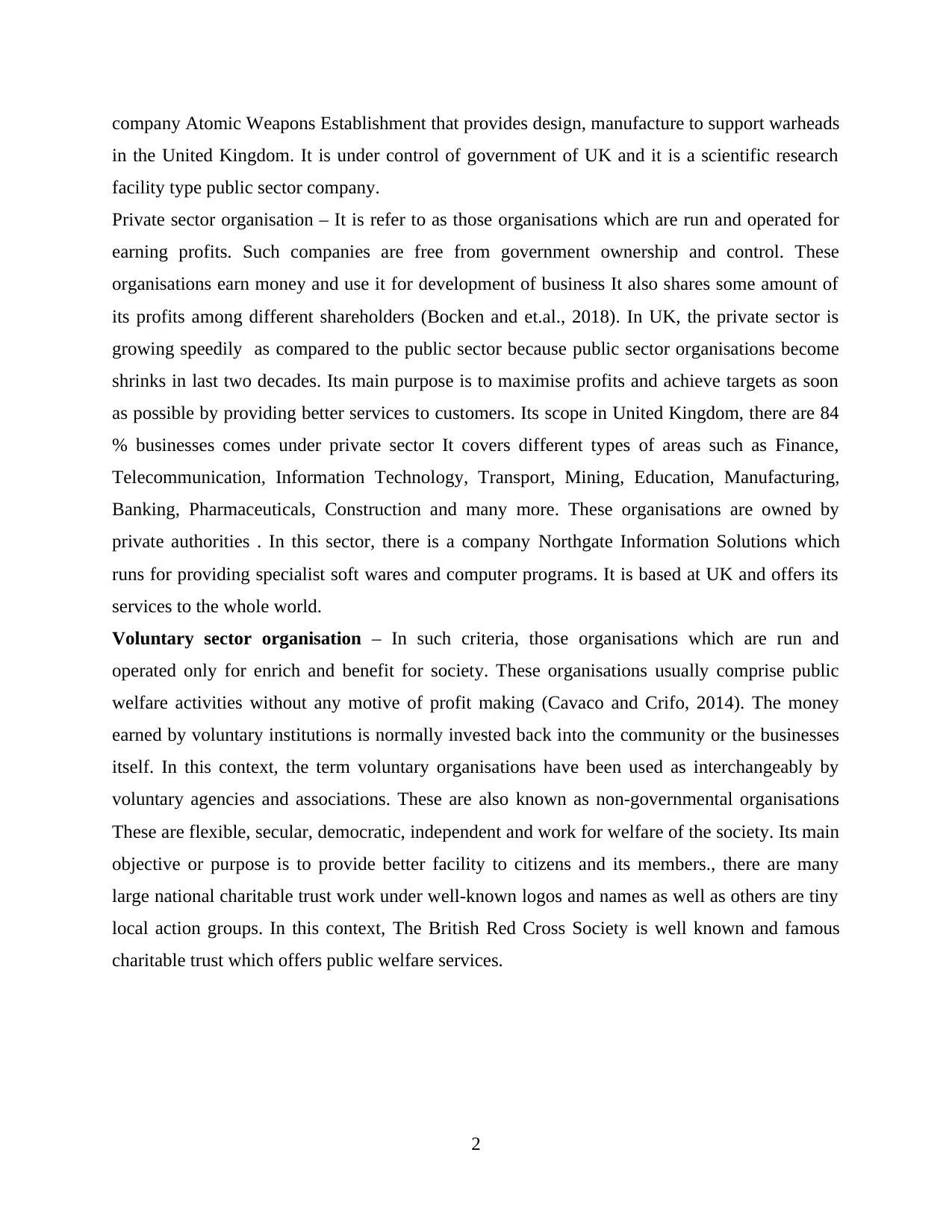
company Atomic Weapons Establishment that provides design, manufacture to support warheads
in the United Kingdom. It is under control of government of UK and it is a scientific research
facility type public sector company.
Private sector organisation – It is refer to as those organisations which are run and operated for
earning profits. Such companies are free from government ownership and control. These
organisations earn money and use it for development of business It also shares some amount of
its profits among different shareholders (Bocken and et.al., 2018). In UK, the private sector is
growing speedily as compared to the public sector because public sector organisations become
shrinks in last two decades. Its main purpose is to maximise profits and achieve targets as soon
as possible by providing better services to customers. Its scope in United Kingdom, there are 84
% businesses comes under private sector It covers different types of areas such as Finance,
Telecommunication, Information Technology, Transport, Mining, Education, Manufacturing,
Banking, Pharmaceuticals, Construction and many more. These organisations are owned by
private authorities . In this sector, there is a company Northgate Information Solutions which
runs for providing specialist soft wares and computer programs. It is based at UK and offers its
services to the whole world.
Voluntary sector organisation – In such criteria, those organisations which are run and
operated only for enrich and benefit for society. These organisations usually comprise public
welfare activities without any motive of profit making (Cavaco and Crifo, 2014). The money
earned by voluntary institutions is normally invested back into the community or the businesses
itself. In this context, the term voluntary organisations have been used as interchangeably by
voluntary agencies and associations. These are also known as non-governmental organisations
These are flexible, secular, democratic, independent and work for welfare of the society. Its main
objective or purpose is to provide better facility to citizens and its members., there are many
large national charitable trust work under well-known logos and names as well as others are tiny
local action groups. In this context, The British Red Cross Society is well known and famous
charitable trust which offers public welfare services.
2
in the United Kingdom. It is under control of government of UK and it is a scientific research
facility type public sector company.
Private sector organisation – It is refer to as those organisations which are run and operated for
earning profits. Such companies are free from government ownership and control. These
organisations earn money and use it for development of business It also shares some amount of
its profits among different shareholders (Bocken and et.al., 2018). In UK, the private sector is
growing speedily as compared to the public sector because public sector organisations become
shrinks in last two decades. Its main purpose is to maximise profits and achieve targets as soon
as possible by providing better services to customers. Its scope in United Kingdom, there are 84
% businesses comes under private sector It covers different types of areas such as Finance,
Telecommunication, Information Technology, Transport, Mining, Education, Manufacturing,
Banking, Pharmaceuticals, Construction and many more. These organisations are owned by
private authorities . In this sector, there is a company Northgate Information Solutions which
runs for providing specialist soft wares and computer programs. It is based at UK and offers its
services to the whole world.
Voluntary sector organisation – In such criteria, those organisations which are run and
operated only for enrich and benefit for society. These organisations usually comprise public
welfare activities without any motive of profit making (Cavaco and Crifo, 2014). The money
earned by voluntary institutions is normally invested back into the community or the businesses
itself. In this context, the term voluntary organisations have been used as interchangeably by
voluntary agencies and associations. These are also known as non-governmental organisations
These are flexible, secular, democratic, independent and work for welfare of the society. Its main
objective or purpose is to provide better facility to citizens and its members., there are many
large national charitable trust work under well-known logos and names as well as others are tiny
local action groups. In this context, The British Red Cross Society is well known and famous
charitable trust which offers public welfare services.
2

Size and scope of different types of organisations
Every organisation has its size and scope that are useful for run its business activities
easily. In this context, there are three different sectors’, its size and scope are describes as
follows:
Public sector
(Atomic Weapons
Establishment)
Private sector
(Northgate
Information
Solutions)
Voluntary sector
(The British Red Cross Society)
Size It was established in
1950 and currently its
director is Ian Couche
known as managing
director. Its major
work is to create new
weapons according to
the requirements.
It is an information
technology company
that manage its basic
services through many
specialists and experts.
It works more than 35
nations with its 9000
staff members
(Kelman and et.al.,
2016). Its chief
executive officer is
Andy Monshaw. The
management team
distributes and
subsequently
manufactures disk
computer system.
It is UK based voluntary
organisation of impartial and neutral
humanitarian network. It was
established in 1870 and its currently
chief executive officer is Mike
Adamasn. It has more than 4000
active employees and nearly 33000
volunteers.
Scope The establishment is
the end goal for the
Campaign for Nuclear
Disarmament's annual
march from Trafalgar
The company
introduced the M9000
a new model that is
use in computers
(called Sequoia in
It is commits for helping those
persons who are poor without any
discrimination, nationality or
religion etc. This organisation has
four main values that are inclusive,
3
Every organisation has its size and scope that are useful for run its business activities
easily. In this context, there are three different sectors’, its size and scope are describes as
follows:
Public sector
(Atomic Weapons
Establishment)
Private sector
(Northgate
Information
Solutions)
Voluntary sector
(The British Red Cross Society)
Size It was established in
1950 and currently its
director is Ian Couche
known as managing
director. Its major
work is to create new
weapons according to
the requirements.
It is an information
technology company
that manage its basic
services through many
specialists and experts.
It works more than 35
nations with its 9000
staff members
(Kelman and et.al.,
2016). Its chief
executive officer is
Andy Monshaw. The
management team
distributes and
subsequently
manufactures disk
computer system.
It is UK based voluntary
organisation of impartial and neutral
humanitarian network. It was
established in 1870 and its currently
chief executive officer is Mike
Adamasn. It has more than 4000
active employees and nearly 33000
volunteers.
Scope The establishment is
the end goal for the
Campaign for Nuclear
Disarmament's annual
march from Trafalgar
The company
introduced the M9000
a new model that is
use in computers
(called Sequoia in
It is commits for helping those
persons who are poor without any
discrimination, nationality or
religion etc. This organisation has
four main values that are inclusive,
3
⊘ This is a preview!⊘
Do you want full access?
Subscribe today to unlock all pages.

Trusted by 1+ million students worldwide
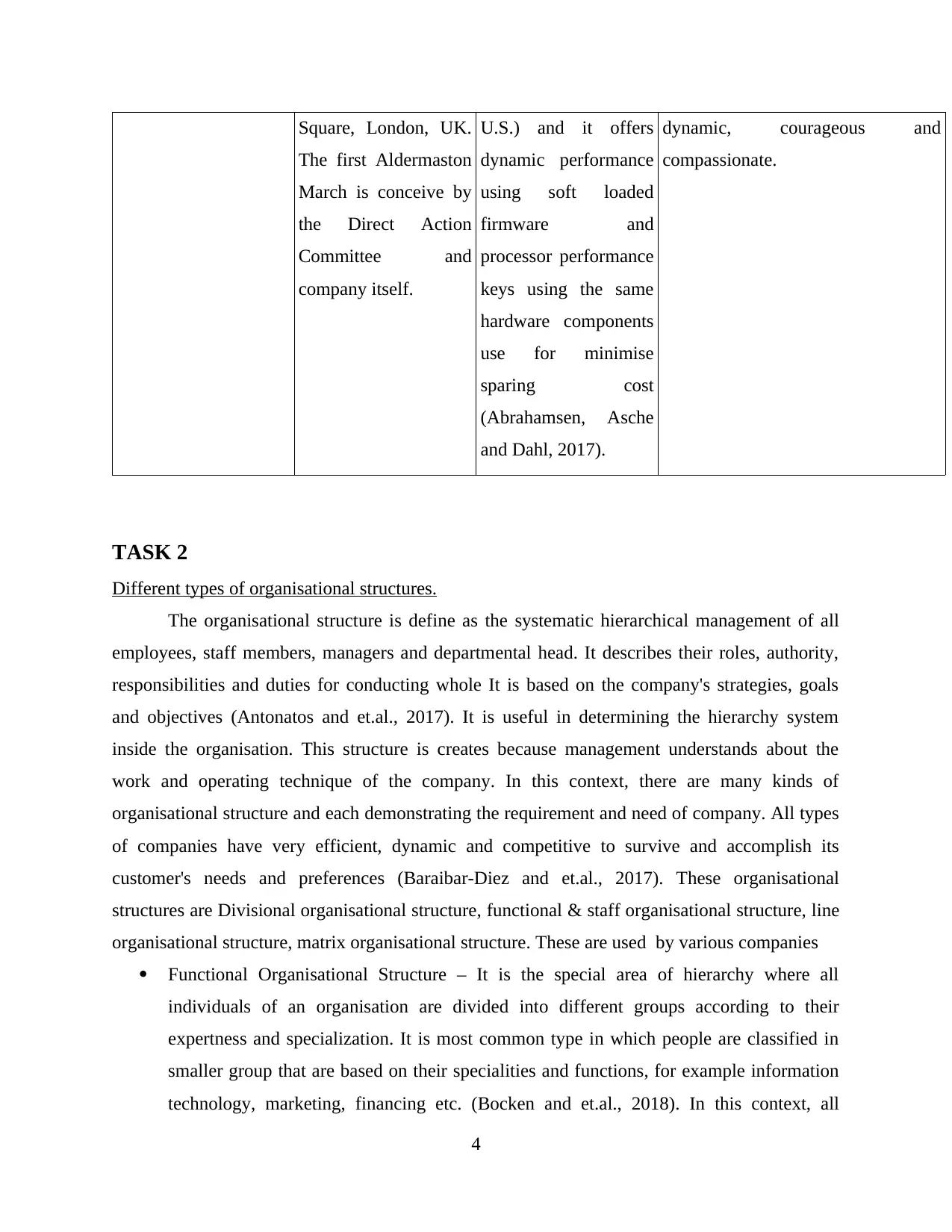
Square, London, UK.
The first Aldermaston
March is conceive by
the Direct Action
Committee and
company itself.
U.S.) and it offers
dynamic performance
using soft loaded
firmware and
processor performance
keys using the same
hardware components
use for minimise
sparing cost
(Abrahamsen, Asche
and Dahl, 2017).
dynamic, courageous and
compassionate.
TASK 2
Different types of organisational structures.
The organisational structure is define as the systematic hierarchical management of all
employees, staff members, managers and departmental head. It describes their roles, authority,
responsibilities and duties for conducting whole It is based on the company's strategies, goals
and objectives (Antonatos and et.al., 2017). It is useful in determining the hierarchy system
inside the organisation. This structure is creates because management understands about the
work and operating technique of the company. In this context, there are many kinds of
organisational structure and each demonstrating the requirement and need of company. All types
of companies have very efficient, dynamic and competitive to survive and accomplish its
customer's needs and preferences (Baraibar‐Diez and et.al., 2017). These organisational
structures are Divisional organisational structure, functional & staff organisational structure, line
organisational structure, matrix organisational structure. These are used by various companies
Functional Organisational Structure – It is the special area of hierarchy where all
individuals of an organisation are divided into different groups according to their
expertness and specialization. It is most common type in which people are classified in
smaller group that are based on their specialities and functions, for example information
technology, marketing, financing etc. (Bocken and et.al., 2018). In this context, all
4
The first Aldermaston
March is conceive by
the Direct Action
Committee and
company itself.
U.S.) and it offers
dynamic performance
using soft loaded
firmware and
processor performance
keys using the same
hardware components
use for minimise
sparing cost
(Abrahamsen, Asche
and Dahl, 2017).
dynamic, courageous and
compassionate.
TASK 2
Different types of organisational structures.
The organisational structure is define as the systematic hierarchical management of all
employees, staff members, managers and departmental head. It describes their roles, authority,
responsibilities and duties for conducting whole It is based on the company's strategies, goals
and objectives (Antonatos and et.al., 2017). It is useful in determining the hierarchy system
inside the organisation. This structure is creates because management understands about the
work and operating technique of the company. In this context, there are many kinds of
organisational structure and each demonstrating the requirement and need of company. All types
of companies have very efficient, dynamic and competitive to survive and accomplish its
customer's needs and preferences (Baraibar‐Diez and et.al., 2017). These organisational
structures are Divisional organisational structure, functional & staff organisational structure, line
organisational structure, matrix organisational structure. These are used by various companies
Functional Organisational Structure – It is the special area of hierarchy where all
individuals of an organisation are divided into different groups according to their
expertness and specialization. It is most common type in which people are classified in
smaller group that are based on their specialities and functions, for example information
technology, marketing, financing etc. (Bocken and et.al., 2018). In this context, all
4
Paraphrase This Document
Need a fresh take? Get an instant paraphrase of this document with our AI Paraphraser
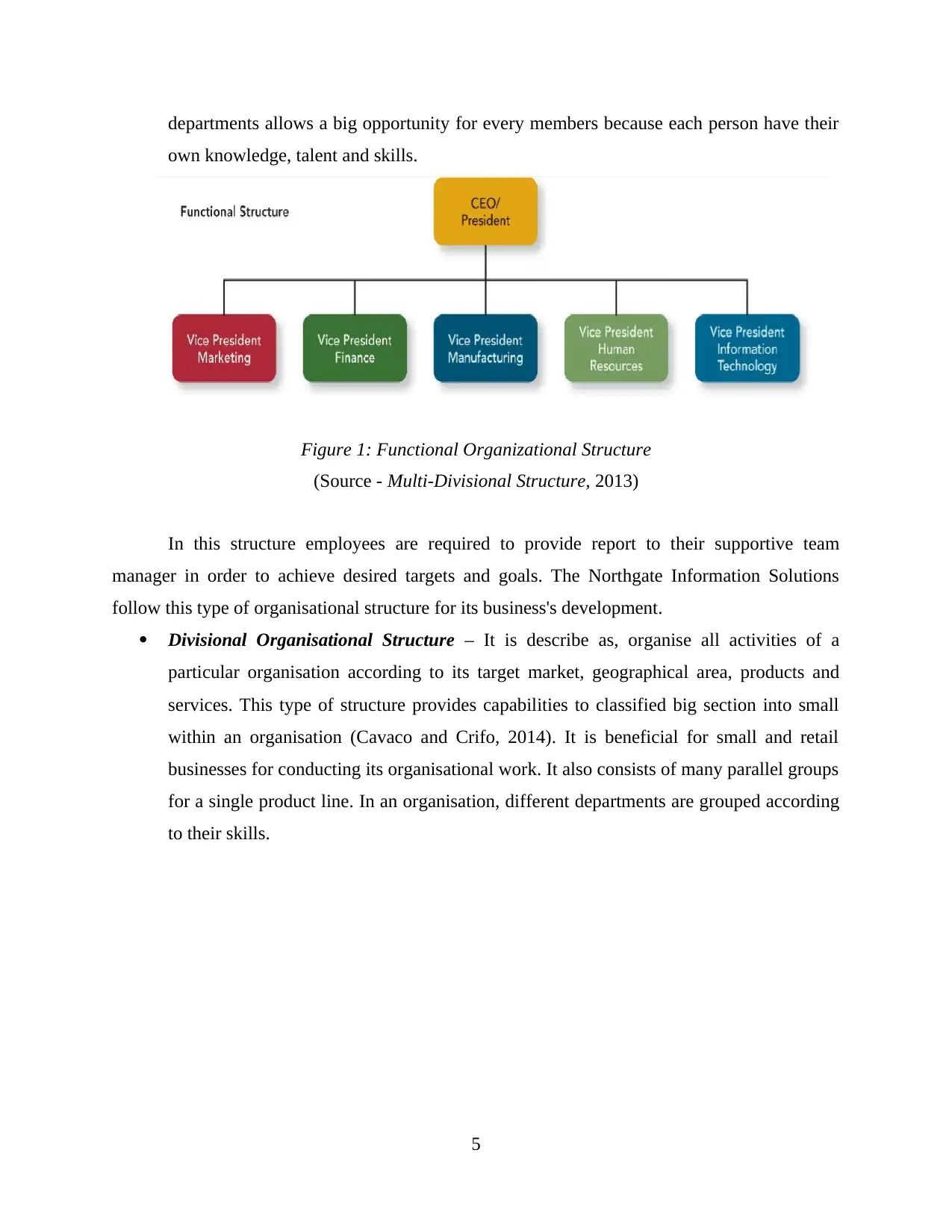
departments allows a big opportunity for every members because each person have their
own knowledge, talent and skills.
Figure 1: Functional Organizational Structure
(Source - Multi-Divisional Structure, 2013)
In this structure employees are required to provide report to their supportive team
manager in order to achieve desired targets and goals. The Northgate Information Solutions
follow this type of organisational structure for its business's development.
Divisional Organisational Structure – It is describe as, organise all activities of a
particular organisation according to its target market, geographical area, products and
services. This type of structure provides capabilities to classified big section into small
within an organisation (Cavaco and Crifo, 2014). It is beneficial for small and retail
businesses for conducting its organisational work. It also consists of many parallel groups
for a single product line. In an organisation, different departments are grouped according
to their skills.
5
own knowledge, talent and skills.
Figure 1: Functional Organizational Structure
(Source - Multi-Divisional Structure, 2013)
In this structure employees are required to provide report to their supportive team
manager in order to achieve desired targets and goals. The Northgate Information Solutions
follow this type of organisational structure for its business's development.
Divisional Organisational Structure – It is describe as, organise all activities of a
particular organisation according to its target market, geographical area, products and
services. This type of structure provides capabilities to classified big section into small
within an organisation (Cavaco and Crifo, 2014). It is beneficial for small and retail
businesses for conducting its organisational work. It also consists of many parallel groups
for a single product line. In an organisation, different departments are grouped according
to their skills.
5
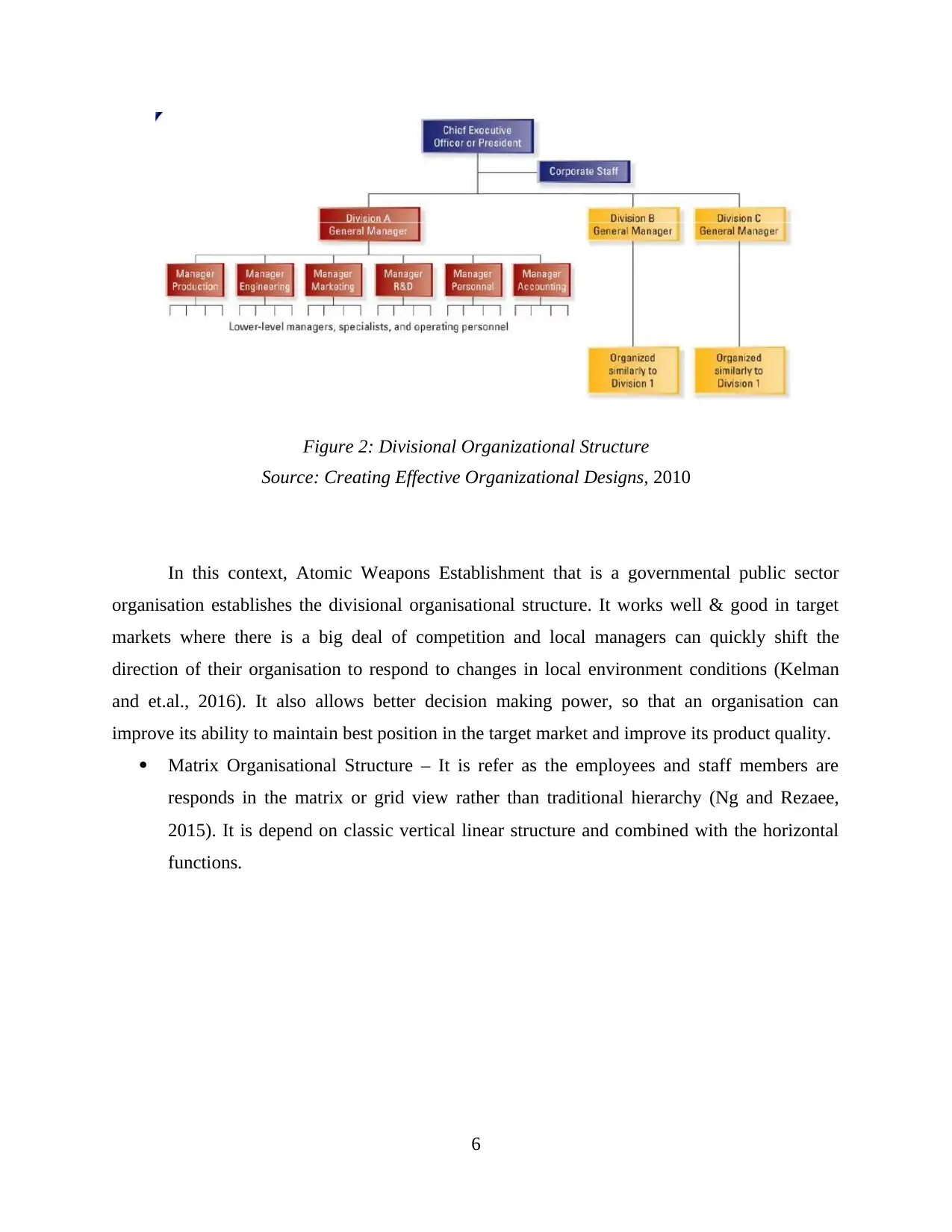
Figure 2: Divisional Organizational Structure
Source: Creating Effective Organizational Designs, 2010
In this context, Atomic Weapons Establishment that is a governmental public sector
organisation establishes the divisional organisational structure. It works well & good in target
markets where there is a big deal of competition and local managers can quickly shift the
direction of their organisation to respond to changes in local environment conditions (Kelman
and et.al., 2016). It also allows better decision making power, so that an organisation can
improve its ability to maintain best position in the target market and improve its product quality.
Matrix Organisational Structure – It is refer as the employees and staff members are
responds in the matrix or grid view rather than traditional hierarchy (Ng and Rezaee,
2015). It is depend on classic vertical linear structure and combined with the horizontal
functions.
6
Source: Creating Effective Organizational Designs, 2010
In this context, Atomic Weapons Establishment that is a governmental public sector
organisation establishes the divisional organisational structure. It works well & good in target
markets where there is a big deal of competition and local managers can quickly shift the
direction of their organisation to respond to changes in local environment conditions (Kelman
and et.al., 2016). It also allows better decision making power, so that an organisation can
improve its ability to maintain best position in the target market and improve its product quality.
Matrix Organisational Structure – It is refer as the employees and staff members are
responds in the matrix or grid view rather than traditional hierarchy (Ng and Rezaee,
2015). It is depend on classic vertical linear structure and combined with the horizontal
functions.
6
⊘ This is a preview!⊘
Do you want full access?
Subscribe today to unlock all pages.

Trusted by 1+ million students worldwide
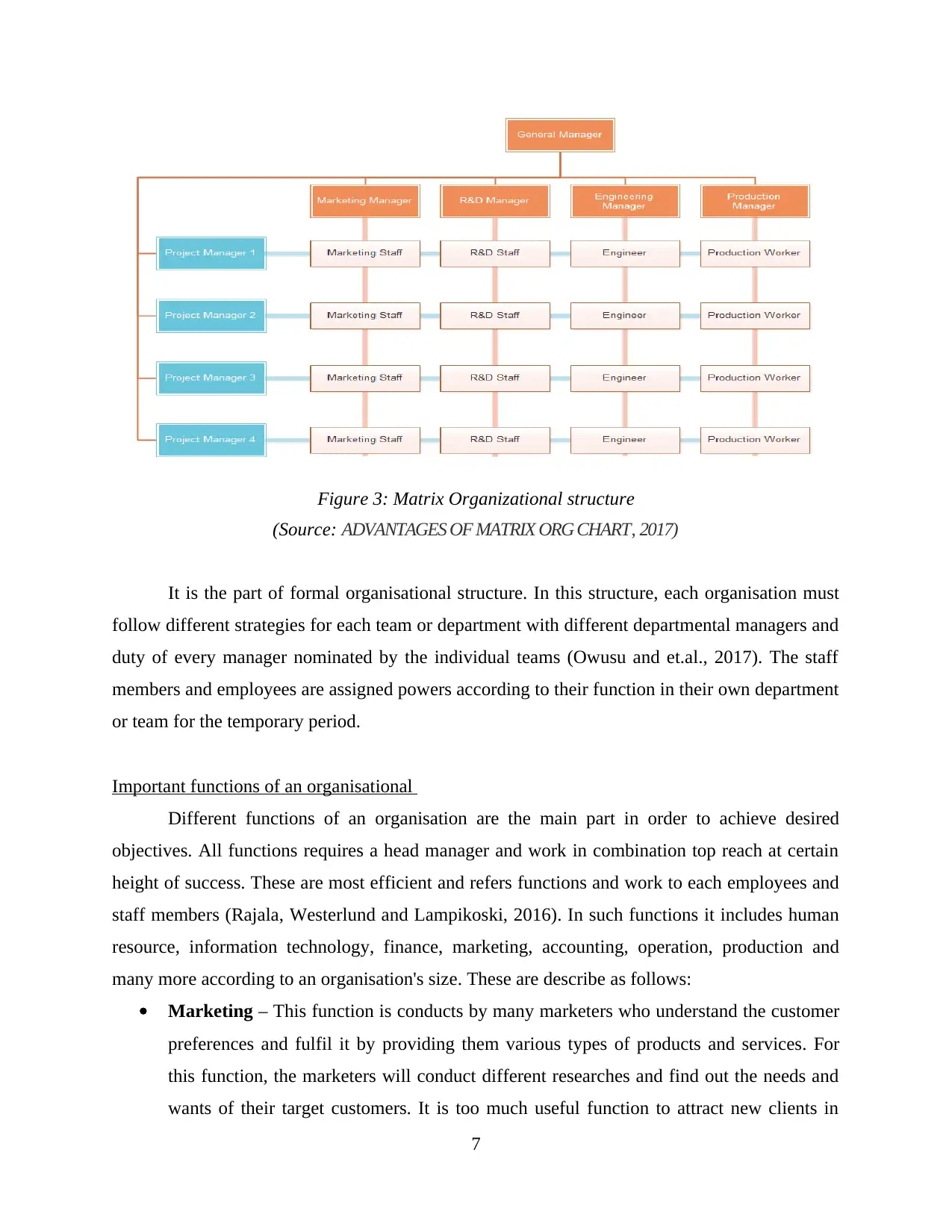
Figure 3: Matrix Organizational structure
(Source: ADVANTAGES OF MATRIX ORG CHART, 2017)
It is the part of formal organisational structure. In this structure, each organisation must
follow different strategies for each team or department with different departmental managers and
duty of every manager nominated by the individual teams (Owusu and et.al., 2017). The staff
members and employees are assigned powers according to their function in their own department
or team for the temporary period.
Important functions of an organisational
Different functions of an organisation are the main part in order to achieve desired
objectives. All functions requires a head manager and work in combination top reach at certain
height of success. These are most efficient and refers functions and work to each employees and
staff members (Rajala, Westerlund and Lampikoski, 2016). In such functions it includes human
resource, information technology, finance, marketing, accounting, operation, production and
many more according to an organisation's size. These are describe as follows:
Marketing – This function is conducts by many marketers who understand the customer
preferences and fulfil it by providing them various types of products and services. For
this function, the marketers will conduct different researches and find out the needs and
wants of their target customers. It is too much useful function to attract new clients in
7
(Source: ADVANTAGES OF MATRIX ORG CHART, 2017)
It is the part of formal organisational structure. In this structure, each organisation must
follow different strategies for each team or department with different departmental managers and
duty of every manager nominated by the individual teams (Owusu and et.al., 2017). The staff
members and employees are assigned powers according to their function in their own department
or team for the temporary period.
Important functions of an organisational
Different functions of an organisation are the main part in order to achieve desired
objectives. All functions requires a head manager and work in combination top reach at certain
height of success. These are most efficient and refers functions and work to each employees and
staff members (Rajala, Westerlund and Lampikoski, 2016). In such functions it includes human
resource, information technology, finance, marketing, accounting, operation, production and
many more according to an organisation's size. These are describe as follows:
Marketing – This function is conducts by many marketers who understand the customer
preferences and fulfil it by providing them various types of products and services. For
this function, the marketers will conduct different researches and find out the needs and
wants of their target customers. It is too much useful function to attract new clients in
7
Paraphrase This Document
Need a fresh take? Get an instant paraphrase of this document with our AI Paraphraser
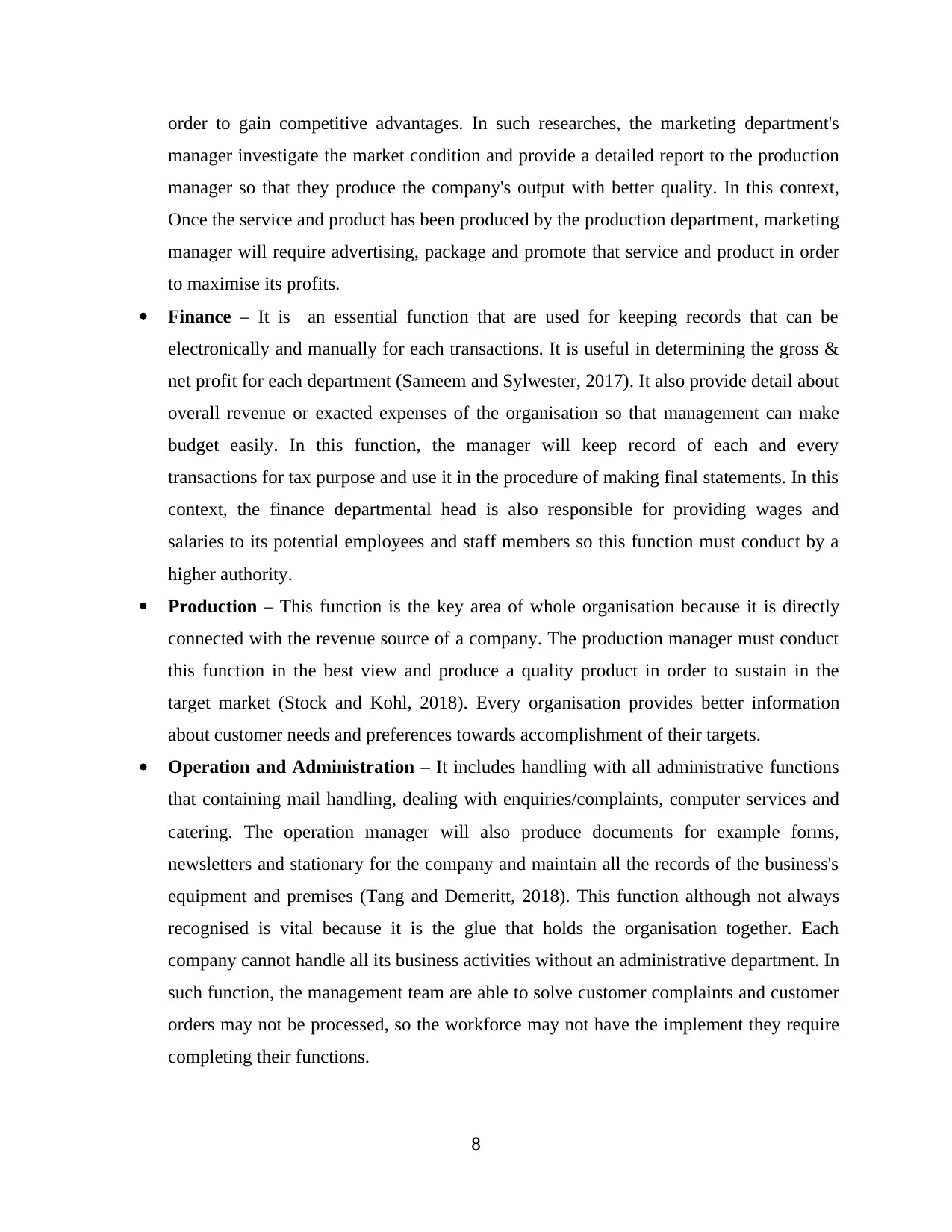
order to gain competitive advantages. In such researches, the marketing department's
manager investigate the market condition and provide a detailed report to the production
manager so that they produce the company's output with better quality. In this context,
Once the service and product has been produced by the production department, marketing
manager will require advertising, package and promote that service and product in order
to maximise its profits.
Finance – It is an essential function that are used for keeping records that can be
electronically and manually for each transactions. It is useful in determining the gross &
net profit for each department (Sameem and Sylwester, 2017). It also provide detail about
overall revenue or exacted expenses of the organisation so that management can make
budget easily. In this function, the manager will keep record of each and every
transactions for tax purpose and use it in the procedure of making final statements. In this
context, the finance departmental head is also responsible for providing wages and
salaries to its potential employees and staff members so this function must conduct by a
higher authority.
Production – This function is the key area of whole organisation because it is directly
connected with the revenue source of a company. The production manager must conduct
this function in the best view and produce a quality product in order to sustain in the
target market (Stock and Kohl, 2018). Every organisation provides better information
about customer needs and preferences towards accomplishment of their targets.
Operation and Administration – It includes handling with all administrative functions
that containing mail handling, dealing with enquiries/complaints, computer services and
catering. The operation manager will also produce documents for example forms,
newsletters and stationary for the company and maintain all the records of the business's
equipment and premises (Tang and Demeritt, 2018). This function although not always
recognised is vital because it is the glue that holds the organisation together. Each
company cannot handle all its business activities without an administrative department. In
such function, the management team are able to solve customer complaints and customer
orders may not be processed, so the workforce may not have the implement they require
completing their functions.
8
manager investigate the market condition and provide a detailed report to the production
manager so that they produce the company's output with better quality. In this context,
Once the service and product has been produced by the production department, marketing
manager will require advertising, package and promote that service and product in order
to maximise its profits.
Finance – It is an essential function that are used for keeping records that can be
electronically and manually for each transactions. It is useful in determining the gross &
net profit for each department (Sameem and Sylwester, 2017). It also provide detail about
overall revenue or exacted expenses of the organisation so that management can make
budget easily. In this function, the manager will keep record of each and every
transactions for tax purpose and use it in the procedure of making final statements. In this
context, the finance departmental head is also responsible for providing wages and
salaries to its potential employees and staff members so this function must conduct by a
higher authority.
Production – This function is the key area of whole organisation because it is directly
connected with the revenue source of a company. The production manager must conduct
this function in the best view and produce a quality product in order to sustain in the
target market (Stock and Kohl, 2018). Every organisation provides better information
about customer needs and preferences towards accomplishment of their targets.
Operation and Administration – It includes handling with all administrative functions
that containing mail handling, dealing with enquiries/complaints, computer services and
catering. The operation manager will also produce documents for example forms,
newsletters and stationary for the company and maintain all the records of the business's
equipment and premises (Tang and Demeritt, 2018). This function although not always
recognised is vital because it is the glue that holds the organisation together. Each
company cannot handle all its business activities without an administrative department. In
such function, the management team are able to solve customer complaints and customer
orders may not be processed, so the workforce may not have the implement they require
completing their functions.
8

Accounting – This function contains all records and information about all monetary and
non-monetary transactions that may happen in an organisation. The accounting manager
conduct this work for checking all written record and it is useful for auditing. It is also
useful for the finance department to maintain financial records and understand the need
of fund.
Information Technology – In present days, internet play an essential role because every
person use internet and purchase online products and use different services (Wang and
et.al., 2015). In this context, company must consider their online customers in order to
offer them better quality services.
Selling – This function is help to determine the quantity of total turnover and it also
describes the net profits that company gain. In this function, the manager of this
department is responsible for persuading the customers to buy the end service and
product that are manufactured through marketing’s research. The Sales Department’s
selling plan and strategy could involve mail shots, telephone sales, travelling sales
representatives and devising various sales interview.
TASK 3
Impact of macro environmental factors on the Northgate Information Solutions organisation.
Every company has its internal and external environmental factors that could affect
organisational work and may influence manager's functions. There are several external factors
for example customers, public, government, suppliers and many more (Abrahamsen, Asche and
Dahl, 2017). All these entities can effect the organisation and it can reduce revenue. Such
elements may impact positively and negatively both aspects. In this context, management should
consider all these elements and need to understand the impacts of macro environmental factors,
there is a standard model PESTLE analysis
Political Factors – It refers to the disturbance in the politics because of governmental
rules and regulations. The Northgate Information Solutions company exists in various
countries so that there is a requirement of accomplishment of all laws and rules by the
management team of this organisation Political factors includes different rules and
regulations in industry, bureaucracy, all legal framework which governs contract,
intellectual property act, patents, copyright, patents, trademarks, trade control,
9
non-monetary transactions that may happen in an organisation. The accounting manager
conduct this work for checking all written record and it is useful for auditing. It is also
useful for the finance department to maintain financial records and understand the need
of fund.
Information Technology – In present days, internet play an essential role because every
person use internet and purchase online products and use different services (Wang and
et.al., 2015). In this context, company must consider their online customers in order to
offer them better quality services.
Selling – This function is help to determine the quantity of total turnover and it also
describes the net profits that company gain. In this function, the manager of this
department is responsible for persuading the customers to buy the end service and
product that are manufactured through marketing’s research. The Sales Department’s
selling plan and strategy could involve mail shots, telephone sales, travelling sales
representatives and devising various sales interview.
TASK 3
Impact of macro environmental factors on the Northgate Information Solutions organisation.
Every company has its internal and external environmental factors that could affect
organisational work and may influence manager's functions. There are several external factors
for example customers, public, government, suppliers and many more (Abrahamsen, Asche and
Dahl, 2017). All these entities can effect the organisation and it can reduce revenue. Such
elements may impact positively and negatively both aspects. In this context, management should
consider all these elements and need to understand the impacts of macro environmental factors,
there is a standard model PESTLE analysis
Political Factors – It refers to the disturbance in the politics because of governmental
rules and regulations. The Northgate Information Solutions company exists in various
countries so that there is a requirement of accomplishment of all laws and rules by the
management team of this organisation Political factors includes different rules and
regulations in industry, bureaucracy, all legal framework which governs contract,
intellectual property act, patents, copyright, patents, trademarks, trade control,
9
⊘ This is a preview!⊘
Do you want full access?
Subscribe today to unlock all pages.

Trusted by 1+ million students worldwide
1 out of 20
Related Documents
Your All-in-One AI-Powered Toolkit for Academic Success.
+13062052269
info@desklib.com
Available 24*7 on WhatsApp / Email
![[object Object]](/_next/static/media/star-bottom.7253800d.svg)
Unlock your academic potential
Copyright © 2020–2025 A2Z Services. All Rights Reserved. Developed and managed by ZUCOL.





